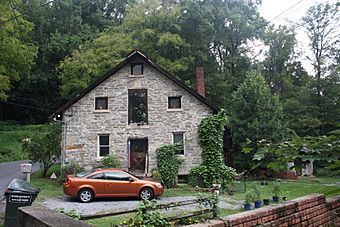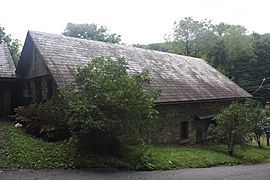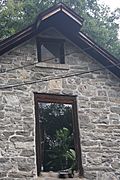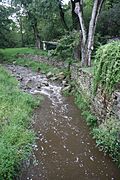Coffeetown Grist Mill facts for kids
The Coffeetown Grist Mill is a very old and important building. It is located in Williams Township, Pennsylvania. This historic mill was built a long, long time ago in 1762.
It's a special kind of building called a "banked mill." This means one side of the building is built into a hill or slope. This design helped people load and unload things easily.
Contents
The Coffeetown Grist Mill: A Historic Building
The Coffeetown Grist Mill is a fascinating piece of history. It stands 2 and a half stories tall on its banked side. The building is quite large, measuring about 36 feet wide and 50 feet long.
Over the years, the mill grew bigger. More parts were added to it during the 1800s. This helped it become the size we see today.
What is a Grist Mill?
A grist mill is a type of factory that uses water power to grind grain. Imagine big, heavy stones turning to crush wheat or corn. This process turns the grain into flour or meal.
People would bring their harvested grains to the mill. The millers would then grind it for them. This was a very important service for communities long ago.
A Look at Its History
The Coffeetown Grist Mill has had many different jobs over the centuries. After its time as a busy mill, it changed purpose. In the 1920s, it was turned into a factory that made fertilizer.
But that's not all! This versatile building also served the community in other ways. For a short time, it was used as a schoolhouse. Children would come here to learn their lessons. It even operated as a local post office.
What is it Used For Now?
Today, the Coffeetown Grist Mill is no longer grinding grain or making fertilizer. It is not a school or a post office either. Instead, this historic building is now a private home. Someone lives there, enjoying its rich history.
A Special Place in History
Because of its long history and importance, the Coffeetown Grist Mill is recognized as a special place. It was added to the National Register of Historic Places in 1977. This list includes buildings, sites, and objects that are important to American history.
Being on this list helps protect the mill. It makes sure that future generations can also learn about its past. It reminds us of how people lived and worked many years ago.
Gallery







